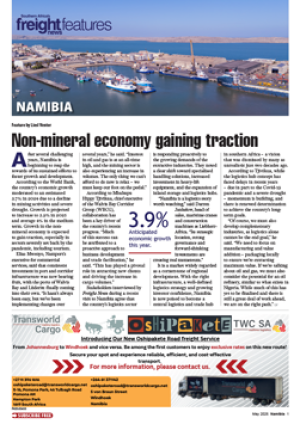What are the implications of
the Hanjin insolvency for all
the parties affected?
To attempt to get answers
to this question, FTW
approached a legal expert
on the situation – Peter
Lamb, senior associate at
Norton Rose Fulbright SA
Incorporated.
And he saw implications
involving all the parties in the
supply chain, with some of
them possibly SA-based.
For marine underwriters, he
told FTW, the relevant factor
is the Institute Cargo Clauses
(A). “This does not cover loss,
damage or expenses caused
by the insolvency or financial
default by the shipowner or
charterer,” he added. “This
where, at the time of loading
of the cargo on board the ship,
the insured (cargo owner)
was aware, or in the ordinary
course of business should have
been aware, that the default
could prevent the prosecution
of the voyage.”
In many instances, Lamb
pointed out, the cargo owner
was unlikely to have known
who the ocean carrier was, let
alone its financial standing.
“This is particularly when the
cargo owner has dealt with
the ocean carrier at armslength.
For example, when the
owner is shipping the cargo
under a freight forwarder’s
house bill of lading.” In
those circumstances, Lamb
advised that the cargo owner
would need to approach
the underwriter, and the
underwriter would need to
consider whether to cover the
costs of forwarding the goods
to destination, or selling the
goods where they had been
abandoned by the carrier.”
The issue involving freight
forwarders will be of concern
to them, according to Lamb.
“Potential claims-customers,”
he said, “may view freight
forwarders as alternative, or
‘deep-pocket’, litigants if they
cannot recover their losses
from Hanjin timeously.”
The primary effects on
uninsured cargo are threefold.
There will be a delay
in shipments due to slow
steaming and ships being
arrested. It will lead to
potentially complicated
and costly
transhipment
operations.
There will also
be a loss of any
freight already
paid.
Meanwhile,
for port and
terminal
operators,
they will be
faced with
uncertainty
over whether
or not to allow Hanjin ships
into their facilities due to
risks of impending arrests.
And arrested vessels – where
Hanjin is not able to put
up security to release the
ship from arrest – lead to
congestion at busy terminals
and other facilities. “And,”
Lamb added, “it is not
known if a commercial
bank would put up security
in circumstances where
the shipowner is insolvent.
Where a claim is covered by a
P&I Club, the
security may
be tendered if
the club’s rules
allow.”
Most
terminals
provide in
their rules
that any ship
under arrest be
removed from
the terminal
regardless
of the
amount of cargo that has
been loaded or discharged.
“This places the shippers
of the cargo, as sellers, in a
dilemma if the ship is forced
to sail with a part cargo,”
Lamb said. “Provision for
such a possibility must be
clearly dealt with in the sale
agreement. If the ship is not
removed from the terminal,
the operators may face a
serious loss of revenue as the
terminal will not be able to
operate at full capacity.”
An added complication,
according to Lamb, is that
Hanjin, the seventh largest
container line, had filed and
had accepted an appeal for
rehabilitation in the Seoul
Central District Court. “This,”
he said, “is a form of business
rescue proceedings, which
generally precedes formal
insolvency.”
Also, Lamb pointed out
that to avoid the problems
of ship arrest Hanjin had
immediately instituted
preventative legal proceedings
in jurisdictions worldwide
to prevent its vessels being
seized. “This,” he added, “as
more of its ships were blocked
from docking at ports in the
wake of its collapse.”
INSERT & CAPTION
Potential claimscustomers
may view
freight forwarders as
alternative, or ‘deeppocket’,
litigants.
– Peter Lamb
How will you be affected?
30 Sep 2016 - by Staff reporter
0 Comments
FTW - 30 Sep 2016

30 Sep 2016
30 Sep 2016
30 Sep 2016
30 Sep 2016
30 Sep 2016
30 Sep 2016
30 Sep 2016
30 Sep 2016
30 Sep 2016
